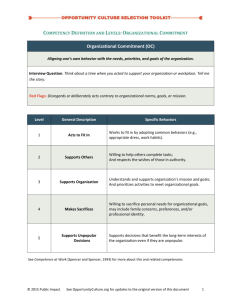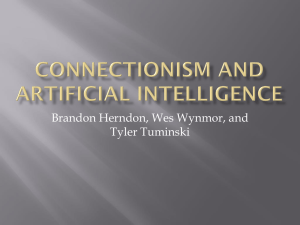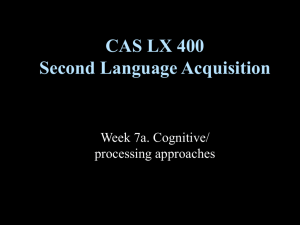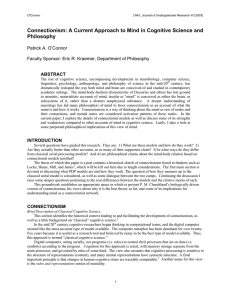A brief history of connectionism and its psychological implications
advertisement
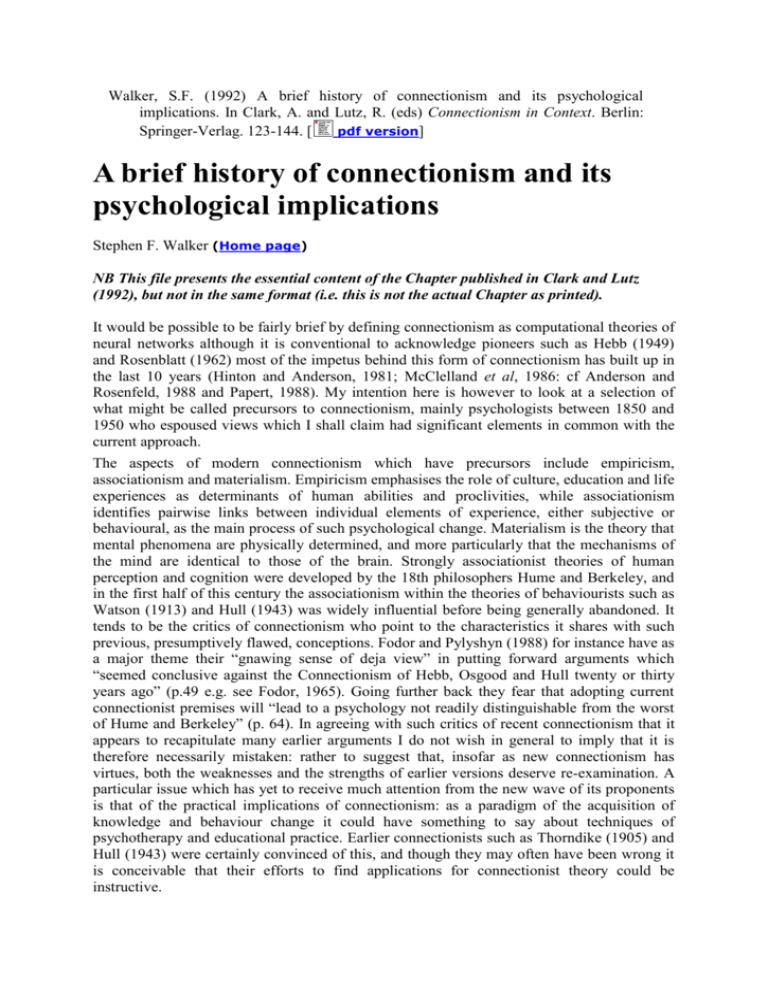
Walker, S.F. (1992) A brief history of connectionism and its psychological implications. In Clark, A. and Lutz, R. (eds) Connectionism in Context. Berlin: Springer-Verlag. 123-144. [ pdf version] A brief history of connectionism and its psychological implications Stephen F. Walker (Home page) NB This file presents the essential content of the Chapter published in Clark and Lutz (1992), but not in the same format (i.e. this is not the actual Chapter as printed). It would be possible to be fairly brief by defining connectionism as computational theories of neural networks although it is conventional to acknowledge pioneers such as Hebb (1949) and Rosenblatt (1962) most of the impetus behind this form of connectionism has built up in the last 10 years (Hinton and Anderson, 1981; McClelland et al, 1986: cf Anderson and Rosenfeld, 1988 and Papert, 1988). My intention here is however to look at a selection of what might be called precursors to connectionism, mainly psychologists between 1850 and 1950 who espoused views which I shall claim had significant elements in common with the current approach. The aspects of modern connectionism which have precursors include empiricism, associationism and materialism. Empiricism emphasises the role of culture, education and life experiences as determinants of human abilities and proclivities, while associationism identifies pairwise links between individual elements of experience, either subjective or behavioural, as the main process of such psychological change. Materialism is the theory that mental phenomena are physically determined, and more particularly that the mechanisms of the mind are identical to those of the brain. Strongly associationist theories of human perception and cognition were developed by the 18th philosophers Hume and Berkeley, and in the first half of this century the associationism within the theories of behaviourists such as Watson (1913) and Hull (1943) was widely influential before being generally abandoned. It tends to be the critics of connectionism who point to the characteristics it shares with such previous, presumptively flawed, conceptions. Fodor and Pylyshyn (1988) for instance have as a major theme their “gnawing sense of deja view” in putting forward arguments which “seemed conclusive against the Connectionism of Hebb, Osgood and Hull twenty or thirty years ago” (p.49 e.g. see Fodor, 1965). Going further back they fear that adopting current connectionist premises will “lead to a psychology not readily distinguishable from the worst of Hume and Berkeley” (p. 64). In agreeing with such critics of recent connectionism that it appears to recapitulate many earlier arguments I do not wish in general to imply that it is therefore necessarily mistaken: rather to suggest that, insofar as new connectionism has virtues, both the weaknesses and the strengths of earlier versions deserve re-examination. A particular issue which has yet to receive much attention from the new wave of its proponents is that of the practical implications of connectionism: as a paradigm of the acquisition of knowledge and behaviour change it could have something to say about techniques of psychotherapy and educational practice. Earlier connectionists such as Thorndike (1905) and Hull (1943) were certainly convinced of this, and though they may often have been wrong it is conceivable that their efforts to find applications for connectionist theory could be instructive. At the outset however, it should be acknowledged that there is a good deal new about the new connectionisms. First, connectionism is now sometimes a synonym for Parallel Distributed Processing: few earlier versions had explicit theories about how networks of connections would work, although appealing to the numerosity of available brain connections is hardly novel. Second, connectionism can now rely on the greatly increased availability of computational analogues and simulations as practical demonstrations of the powers of arrays of connections, as opposed to vague speculations. A previous empirical base for theories about how the effects of experience could be mediated by changed connection weights was in experiments on animal learning. There are those today who are sceptical about the claims made for the capacities of simulated neural nets, but these provide a source of evidence very different in kind from that previously appealed to - networks so far proposed may have limitations for instance in their capacities for learning the past tense (Pinker and Prince, 1988), but they have certain obvious advantages over the laboratory rat for modelling this sort of human cognitive capacity. Finally, some earlier versions of connectionism were strongly Behaviourist, stressing connections between identifiable stimuli and responses, which was a severe theoretical restraint. Papert (1988; p. 9) still sees connectionism as “behaviourism in computer’s clothing” but makes it clear that it is the empiricism in connectionism he is most concerned with - neo-connectionism is empiricist in as far as it is about learning rules, but not behaviourist in the sense having an excessive concern with behavioural measurements. Given these differences it may seem to be stretching a point to include empiricist philosophers and animal learning theorists in the same category as the San Diego PDP group. I therefore attempt to show below in synoptic accounts of earlier work that there are indeed putative similarities to modern connectionist approaches, before reviewing the relationship between them and considering the extent to which recent developments mean that old reservations about connectionism can be safely withdrawn. Connectionist assumptions in earlier psychologies Spencer’s Principles of Psychology (1855/1899) There is no shortage of associationists, empiricists, and materialists, in various combinations, before the 19th Century. Apart from Hume and Berkelely as associationists, in the 18th century Hartley (1749) can be used as an early example of associationism tied to connections between “brain vibrations”, and de la Mettrie’s “Man a Machine” (1748) was a thoroughgoing materialist version of associationism. Spencer is of greater interest partly because of the emphasis he placed on physiological detail and biological evolution (however inaccurately) but also because he had a strong influence on both psychologists and physiologists (see Boakes, 1984). The datedness of Spencer’s physiology for the modern reader may be balanced by the fact the Sherrington (1906) still quoted him as an authority whose ideas were being confirmed and Pavlov (1927; p. 9) credited him with the initial idea of interpreting behavioural reactions as neural reflexes (both Sherrington and Pavlov won Nobel prizes for physiological work on reflexes). Hughlings Jackson, the English neurologist mentioned by McClelland et al (1986, p. 41) in the context of PDP, frequently quotes Spencer and made extensive use of his notion of neural hierarchies (Jackson, 1888/1931). Spencer’s neural nets For Spencer the “data of psychology” started with the structure and function of the nervous system, and all subjective mental phenomena, including those of reasoning as well as perception, were to be related to neural mechanisms (Education, Ethics, Sociology and so on being analysable in terms of similar basic principles). Examination of the facts of “minute nervous structure” indicated branching and intermingling processes. The vague and general deduction is that “nervous communication” within a matrix of cells changes as a function of its activity (vol II; p.545). All intelligence, from its lowest to its highest forms, can be interpreted in terms of associations between successive psychological states (I. p. 425) which are driven by “the strengths of the connexion between the internal states” (I. p. 409). The most basic laws of association apply to “immediately connected changes, and small groups of changes” (I. p. 408). Spencer thus comes very close to saying that “knowledge is in the connections” (Rumelhart and McClelland, 1986a, p. 132). The strength of the connections varies with use by something analogous to the Hebb rule. But perhaps the most striking aspect of Spencer’s treatment is his emphasis on the importance of “concatenations of changes” (I. p. 408) and his explicit reference to neural networks (e.g. “network of their connexions” vol I, p. 544; he more frequently used the synonym “plexus” for network, e.g. vol I pp. 538-553 passim). The analysis of how networks might operate was of course superficial, but Spencer went so far as to sketch a diagram of the most basic neural net of much the same kind as may be found in more recent treatments (see Figure I). Localization. Despite relying on interactions between networks in higher and lower centres, Spencer was firmly in favour of localization of function, as “the law of all organization whatever” (I. p. 571- 3), while denying the phrenological view that defined faculties could reside in local cortical regions. His argument for what we would call distributed representation was partly in terms of the overlapping and entanglement of different networks (I. p. 574) and in terms of “diffused localization” in any individual net (I. p. 362) There is an explicit rejection of the “grandmother cell” concept of perception: “No one excited fibre or cell produces consciousness of an external object” — a different collection of cells may be involved depending on slight differences of presentation. The mechanical analogy appealed to is that of a piano with 100 keys. Five keys struck together yield over 75 million combinations, 50 keys a thirty figure number, and we are invited to consider the possibilities presented by the excitement of clusters of retinal elements - not as an example of the combinatorial explosion, but as an illustration of the relatively large number of perceptual experiences it would be possible to relate to a relatively small central network of cells (vol I, p. 562-3). Limits of experience. His concern with the evolution of neural organization meant that Spencer rejected extreme versions of empiricism − the “experience hypothesis”. Pre-established relations exist in the nervous system “answering to relations in the environment”, and more complex kinds are evident in the gradual changes in cognitive ability seen during childhood, which are “more attributable to the completion of cerebral organization, than to the individual experiences” (I. p.469). Spencer would not therefore have had any difficulty bringing anti-empiricist views such as those associated with Piaget and Chomsky into his system. (It is all the more regrettable that it is in this context that he tends to appeal, unnecessarily, to Lamarkian evolutionary mechanisms, and inherited racial differences) William James's Principles of Psychology William James's Principles has been reprinted innumerable times since 1890, most recently in the Harvard paperback edition of 1983. As he had used Spencer’s work with the same title as a textbook for many years it is not surprising that James’ Principles share with Spencer’s the major features of interpreting subjective mental phenomena in terms of brain activity, and describing the brain activity in terms of neurally mediated associations. There is a substantial chapter on “Functions of the Brain” (beginning with the frog’s brain and going on to human aphasia and visual agnosia), and neural physiology is referred to in the context of more cognitive topics, not only mental association but also willed action (James 1890/1983 p. 1190). Figure 1. Connectionist diagrams
